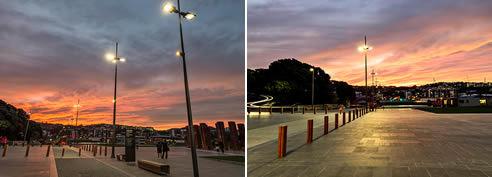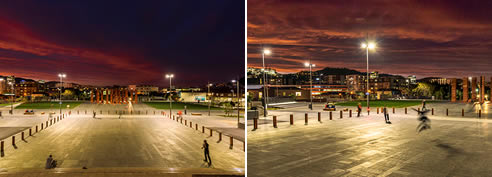Coastal Precinct LED Lighting Solutions from WE-EF

84 WE-EF luminaires were installed across the project in six different configurations.
Creating a memorial park of remembrance in Wellington
New Zealand's war memorials in the nation's capital, Wellington, are not lone monuments but rather are significant and cherished sites of remembrance following the creation of a visitor-friendly precinct opened in April 2015.
In 2012, the New Zealand Government announced its plan to create Pukeahu National War Memorial Park in Wellington. The plan included putting Buckle Street underground in order to create a unified area, improve the setting of the National War Memorial, make additional space for significant days of remembrance and strengthen the heritage value of the entire area. The park incorporates the Hall of Memories, Tomb of the Unknown Warrior and ANZAC monuments that include a 'special' section acknowledging the country's relationship with Australia.
WE-EF, through its sales partner, Mark Herring Lighting Ltd. (MHL), provided the lighting equipment for the park, tunnel entrance, underpass and feeder roads.
"WE-EF was selected in the end because of performance, looks and durability in a coastal city such as Wellington," according to Trevor Simpson from MHL.
Wellington sits near the North Island's southernmost point, a compact city encompassing a waterfront promenade, sandy beaches, a working harbour and colourful timber houses on surrounding hills. Although sunny and mild for most of the year, strong winter winds through the Cook Strait give it the nickname "Windy Wellington."
The lighting design started with a WE-EF PFL540 LED street and area lighting luminaire roadshow presentation, after which a concept was created in collaboration with the project electrical engineer and subsequently approved by the landscape architect. "Getting approval to use the PFL on the state-owned NZ Transit road network was a huge hurdle that was successfully overcome," Trevor Simpson pointed out.


PFL540 LED luminaires provide lighting to the P6 category for the assembly pedestrian areas.
The use of LED technology was not in question as it was the only light source considered by the New Zealand Government for this project. "We also added the option to dim the fittings in order to offer power saving that, in turn, will also extend the life of the LEDs," Trevor Simpson said. "The control gear in the luminaires is subsequently connected to a time clock relay, a daylight sensor and movement sensors."
MHL used a multitude of configurations of the PFL540 LED luminaire "because some of the roadway widths had issues with spill light, glare and uniformity," Trevor Simpson explained. "A number of designs were also incorporated to make the design comply with the standard as well as to push light forward together with a 'side throw' optic." In total, 84 WE-EF luminaires were installed across the project in six different configurations.
It is a testament to those working on the project, and a contributing factor in WE-EF being selected for the project, that custom-designed lighting equipment was delivered within such a short timeframe. This included the presentation of the AML-K pole to the council, engineers and landscape architects for feedback, and collaboration with WE-EF in supplying the luminaires with a 'special' colour powdercoating.
Aside from the timeframe and customisation challenges, WE-EF complied with the necessary regulatory bodies to ensure that the lighting, especially for the roadway applications, met the requirements. "For example, V3 standards were applied for the highway, P3 (NZ) for the feeder roads and P6 for the assembly pedestrian areas," Trevor Simpson explained.
He said the finished project and the stunning visual amenity that it provided, certainly matched up with the original vision of the entire design team.
The next stage of the project, for which WE-EF has also been engaged, is different again as it relates to a fly-over bridge. "As the fittings require a mounting height of approximately 20 metres, strict adherence to glare and spill light calculations will have to be ensured," Trevor Simpson noted. "Also the fact that the project is less than two kilometres from the ocean means that the <0.1% copper LM6 aluminium offered a strong sales angle due to its longevity and lower maintenance requirements," he added.
MHL is now assisting with Stage Three of the project - the development of a fly-over bridge to ease traffic congestion - including a continuation of the PFL240 design from WE-EF.

|






 Modern Catenary Solution Fit for
Modern Catenary Solution Fit for WE-EF's New Managing Director for
WE-EF's New Managing Director for A New Era for WE-EF LIGHTING – A Home
A New Era for WE-EF LIGHTING – A Home Myers Park Lighting Upgrade:
Myers Park Lighting Upgrade: Bridging the Past and Future: Old Murray
Bridging the Past and Future: Old Murray WE-EF Profile Projectors for Sharper
WE-EF Profile Projectors for Sharper Award-winning Bay Pavilions, Arts +
Award-winning Bay Pavilions, Arts + Enhancing Transit Experience at Byron
Enhancing Transit Experience at Byron Intelligently Illuminating the Bay Run
Intelligently Illuminating the Bay Run WE-EF Lighting's Role in Protecting
WE-EF Lighting's Role in Protecting Sustainable LED Upgrade Kit from WE-EF
Sustainable LED Upgrade Kit from WE-EF A Natural Paradise Rottnest Island by
A Natural Paradise Rottnest Island by WE-EF LIGHTING's Braeside Expansion
WE-EF LIGHTING's Braeside Expansion Street and Area Pole-Mounted Luminaires
Street and Area Pole-Mounted Luminaires Smart Lighting Control Technology from
Smart Lighting Control Technology from High-Output Floodlights with Modern LED
High-Output Floodlights with Modern LED Bondi Beach Pavilion Reimagined by WE-EF
Bondi Beach Pavilion Reimagined by WE-EF Balancing Needs: Sea Turtle Conservation
Balancing Needs: Sea Turtle Conservation Architecturally Pleasing Recessed
Architecturally Pleasing Recessed Luminaires for Lake Macquarie Multi-Arts
Luminaires for Lake Macquarie Multi-Arts
